

Compact Muon Solenoid
LHC, CERN
| CMS-BPH-18-004 ; CERN-EP-2021-271 | ||
| Observation of ${\mathrm{B}^{0} \to\psi(\text{2S}) {\mathrm{K^0_S}}\pi^{+}\pi^{-}}$ and ${{\mathrm{B^{0}_{s}}} \to\psi(\text{2S}) {\mathrm{K^0_S}} }$ decays | ||
| CMS Collaboration | ||
| 22 January 2022 | ||
| Eur. Phys. J. C 82 (2022) 499 | ||
| Abstract: Using a data sample of $\sqrt{s} = $ 13 TeV proton-proton collisions collected by the CMS experiment at the LHC in 2017 and 2018 with an integrated luminosity of 103 fb$^{-1}$, the ${{\mathrm{B^{0}_{s}}} \to\psi(\text{2S}) {\mathrm{K^0_S}} }$ and ${\mathrm{B}^{0} \to\psi(\text{2S}) {\mathrm{K^0_S}}\pi^{+}\pi^{-}}$ decays are observed with significances exceeding 5 standard deviations. The resulting branching fraction ratios, measured for the first time, correspond to ${\mathcal{B}} ({{\mathrm{B^{0}_{s}}} \to\psi(\text{2S}) {\mathrm{K^0_S}} } )/{\mathcal{B}} ({\mathrm{B}^{0} \to\psi(\text{2S}) {\mathrm{K^0_S}} } ) = $ (3.33 $\pm$ 0.69 (stat) $\pm$ 0.11 (syst) $\pm$ 0.34 (${f_\mathrm{s}/f_\mathrm{d}} $)) $\times$ 10$^{-2}$ and ${\mathcal{B}} ({\mathrm{B}^{0} \to\psi(\text{2S}) {\mathrm{K^0_S}}\pi^{+}\pi^{-}})/{\mathcal{B}} ({\mathrm{B}^{0} \to\psi(\text{2S}) {\mathrm{K^0_S}} } ) = $ 0.480 $\pm$ 0.013 (stat) $\pm$ 0.032 (syst), where the last uncertainty in the first ratio is related to the uncertainty in the ratio of production cross sections of ${\mathrm{B^{0}_{s}}} $ and ${\mathrm{B}^{0}} $ mesons, ${f_\mathrm{s}/f_\mathrm{d}} $. | ||
| Links: e-print arXiv:2201.09131 [hep-ex] (PDF) ; CDS record ; inSPIRE record ; HepData record ; CADI line (restricted) ; | ||
| Figures | |
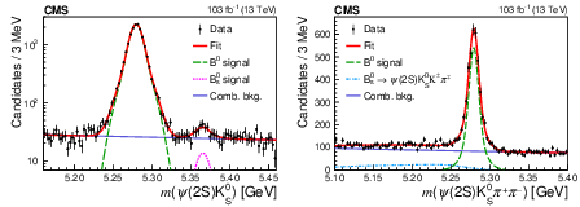
png pdf |
Figure 1:
Measured invariant mass distributions of $ \psi(\text{2S}) {\mathrm{K^0_S}} $ (left) and $ \psi(\text{2S}) {\mathrm{K^0_S}} {{\pi^{+}} {\pi^{-}}} $ (right) candidates. The overlaid results from the fit are described in the text. |

png pdf |
Figure 1-a:
Measured invariant mass distribution of $ \psi(\text{2S}) {\mathrm{K^0_S}} $ candidates. The overlaid results from the fit are described in the text. |
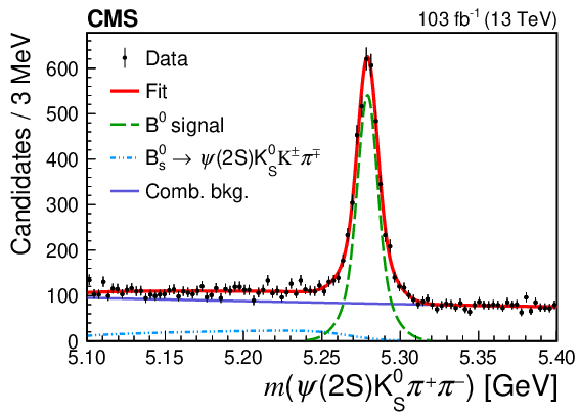
png pdf |
Figure 1-b:
Measured invariant mass distribution of $ \psi(\text{2S}) {\mathrm{K^0_S}} {{\pi^{+}} {\pi^{-}}} $ candidates. The overlaid results from the fit are described in the text. |
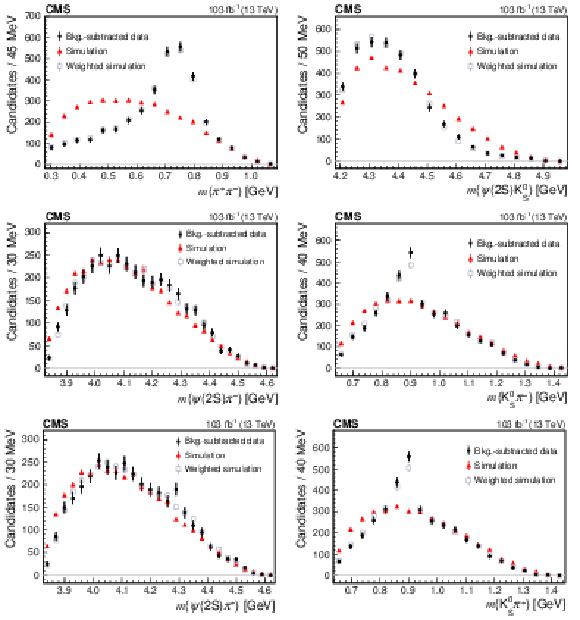
png pdf |
Figure 2:
Distributions of 2-body intermediate invariant masses from the ${\mathrm{B}^{0} \to \psi(\text{2S}) {\mathrm{K^0_S}} {\pi^{+}} {\pi^{-}}}$ decay. The data distributions (black dots) are background subtracted. Overlaid are the predictions of phase space simulations (red triangles), as well as the predictions after applying the reweighting procedure described in Section 7 (grey squares). |
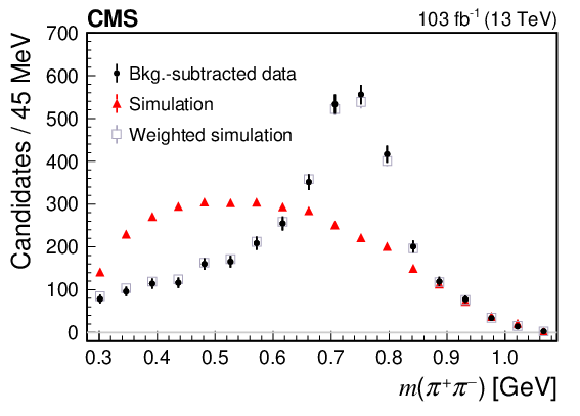
png pdf |
Figure 2-a:
Distribution of the $\pi^{+}\pi^{-}$ invariant mass from the ${\mathrm{B}^{0} \to \psi(\text{2S}) {\mathrm{K^0_S}} {\pi^{+}} {\pi^{-}}}$ decay. The data distribution (black dots) is background subtracted. Overlaid are the predictions of phase space simulations (red triangles), as well as the predictions after applying the reweighting procedure described in Section 7 (grey squares). |
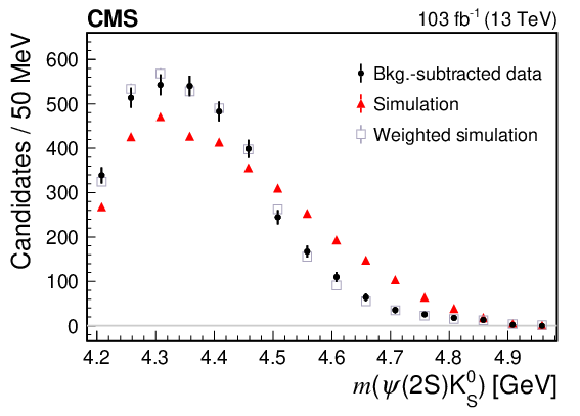
png pdf |
Figure 2-b:
Distribution of the $\psi(\text{2S}\mathrm{K^0_S}$ invariant mass from the ${\mathrm{B}^{0} \to \psi(\text{2S}) {\mathrm{K^0_S}} {\pi^{+}} {\pi^{-}}}$ decay. The data distribution (black dots) is background subtracted. Overlaid are the predictions of phase space simulations (red triangles), as well as the predictions after applying the reweighting procedure described in Section 7 (grey squares). |

png pdf |
Figure 2-c:
Distribution of the $\psi(\text{2S}\pi^{-}$ invariant mass from the ${\mathrm{B}^{0} \to \psi(\text{2S}) {\mathrm{K^0_S}} {\pi^{+}} {\pi^{-}}}$ decay. The data distribution (black dots) is background subtracted. Overlaid are the predictions of phase space simulations (red triangles), as well as the predictions after applying the reweighting procedure described in Section 7 (grey squares). |
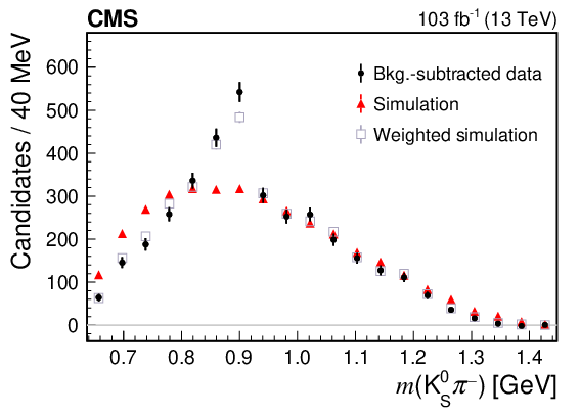
png pdf |
Figure 2-d:
Distribution of the $\mathrm{K^0_S}\pi^{-}$ invariant mass from the ${\mathrm{B}^{0} \to \psi(\text{2S}) {\mathrm{K^0_S}} {\pi^{+}} {\pi^{-}}}$ decay. The data distribution (black dots) is background subtracted. Overlaid are the predictions of phase space simulations (red triangles), as well as the predictions after applying the reweighting procedure described in Section 7 (grey squares). |

png pdf |
Figure 2-e:
Distribution of the $\psi(\text{2S}\pi^{+}$ invariant mass from the ${\mathrm{B}^{0} \to \psi(\text{2S}) {\mathrm{K^0_S}} {\pi^{+}} {\pi^{-}}}$ decay. The data distribution (black dots) is background subtracted. Overlaid are the predictions of phase space simulations (red triangles), as well as the predictions after applying the reweighting procedure described in Section 7 (grey squares). |

png pdf |
Figure 2-f:
Distribution of the $\mathrm{K^0_S}\pi^{+}$ invariant mass from the ${\mathrm{B}^{0} \to \psi(\text{2S}) {\mathrm{K^0_S}} {\pi^{+}} {\pi^{-}}}$ decay. The data distribution (black dots) is background subtracted. Overlaid are the predictions of phase space simulations (red triangles), as well as the predictions after applying the reweighting procedure described in Section 7 (grey squares). |
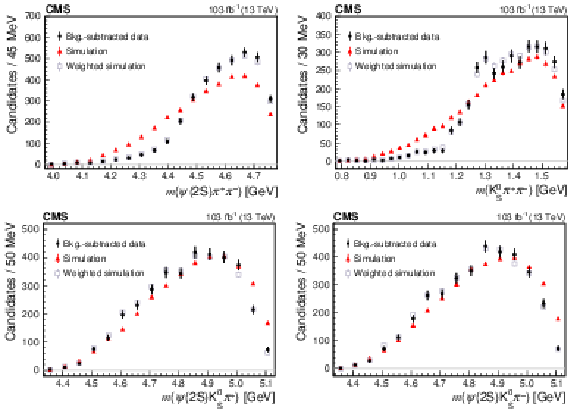
png pdf |
Figure 3:
Distributions of 3-body intermediate invariant masses from the ${\mathrm{B}^{0} \to \psi(\text{2S}) {\mathrm{K^0_S}} {\pi^{+}} {\pi^{-}}}$ decay. Data distributions (black dots) are background subtracted. Overlaid are the predictions of phase space simulations (red triangles), as well as the predictions after applying the reweighting procedure described in Section 7 (grey squares). |

png pdf |
Figure 3-a:
Distribution of the $\psi(\text{2S})\pi^{+}\pi^{-}$ invariant mass from the ${\mathrm{B}^{0} \to \psi(\text{2S}) {\mathrm{K^0_S}} {\pi^{+}} {\pi^{-}}}$ decay. The data distribution (black dots) is background subtracted. Overlaid are the predictions of phase space simulations (red triangles), as well as the predictions after applying the reweighting procedure described in Section 7 (grey squares). |
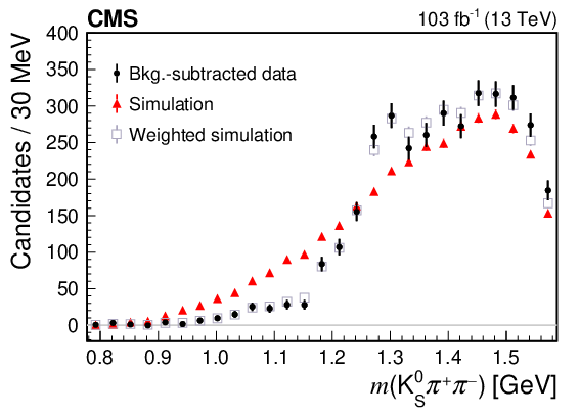
png pdf |
Figure 3-b:
Distribution of the ${\mathrm{K^0_S}}\pi^{+}\pi^{-}$ invariant mass from the ${\mathrm{B}^{0} \to \psi(\text{2S}) {\mathrm{K^0_S}} {\pi^{+}} {\pi^{-}}}$ decay. The data distribution (black dots) is background subtracted. Overlaid are the predictions of phase space simulations (red triangles), as well as the predictions after applying the reweighting procedure described in Section 7 (grey squares). |

png pdf |
Figure 3-c:
Distribution of the $\psi(\text{2S}){\mathrm{K^0_S}}\pi^{+}$ invariant mass from the ${\mathrm{B}^{0} \to \psi(\text{2S}) {\mathrm{K^0_S}} {\pi^{+}} {\pi^{-}}}$ decay. The data distribution (black dots) is background subtracted. Overlaid are the predictions of phase space simulations (red triangles), as well as the predictions after applying the reweighting procedure described in Section 7 (grey squares). |
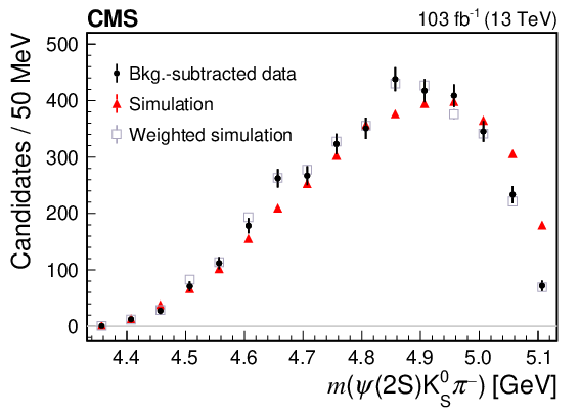
png pdf |
Figure 3-d:
Distribution of the $\psi(\text{2S}){\mathrm{K^0_S}}\pi^{-}$ invariant mass from the ${\mathrm{B}^{0} \to \psi(\text{2S}) {\mathrm{K^0_S}} {\pi^{+}} {\pi^{-}}}$ decay. The data distribution (black dots) is background subtracted. Overlaid are the predictions of phase space simulations (red triangles), as well as the predictions after applying the reweighting procedure described in Section 7 (grey squares). |

png pdf |
Figure 4:
Background-subtracted $ {p_{\mathrm {T}}} ({\mathrm{B}^{0}})$ distribution in data for the ${\mathrm{B}^{0} \to \psi(\text{2S}) {\mathrm{K^0_S}}}$ signal. The last bin includes the overflow. |
| Tables | |

png pdf |
Table 1:
Systematic uncertainties (in %) of the measured branching fraction ratios. |
| Summary |
| The ${{\mathrm{B^{0}_{s}}} \to\psi(\text{2S}) {\mathrm{K^0_S}} }$ and ${\mathrm{B}^{0} \to\psi(\text{2S}) {\mathrm{K^0_S}}\pi^{+}\pi^{-}}$ decays are observed using proton-proton collision data collected by the CMS experiment at 13 TeV with an integrated luminosity of 103 fb$^{-1}$. Their branching fractions are measured with respect to the ${\mathrm{B}^{0} \to\psi(\text{2S}) {\mathrm{K^0_S}} }$ decay to be ${\mathcal{B}} ({{\mathrm{B^{0}_{s}}} \to\psi(\text{2S}) {\mathrm{K^0_S}} } )/{\mathcal{B}} ({\mathrm{B}^{0} \to\psi(\text{2S}) {\mathrm{K^0_S}} } ) = $ (3.33 $\pm$ 0.69 (stat) $\pm$ 0.11 (syst) $\pm$ 0.34 (${f_\mathrm{s}/f_\mathrm{d}} $)) $\times$ 10$^{-2}$, and ${\mathcal{B}} ({\mathrm{B}^{0} \to\psi(\text{2S}) {\mathrm{K^0_S}}\pi^{+}\pi^{-}})/{\mathcal{B}} ({\mathrm{B}^{0} \to\psi(\text{2S}) {\mathrm{K^0_S}} } )= $ 0.480 $\pm$ 0.013 (stat) $\pm$ 0.032 (syst), where the last uncertainty in the first ratio corresponds to the uncertainty in the ratio of production cross sections of ${\mathrm{B^{0}_{s}}}$ and ${\mathrm{B}^{0}}$ mesons. The 2- and 3-body invariant mass distributions of the ${\mathrm{B}^{0} \to\psi(\text{2S}) {\mathrm{K^0_S}}\pi^{+}\pi^{-}}$ decay products do not show significant exotic narrow structures in addition to the known light meson resonances. Further studies with more data will be needed to investigate more precisely the internal dynamics of the ${\mathrm{B}^{0} \to\psi(\text{2S}) {\mathrm{K^0_S}}\pi^{+}\pi^{-}}$ decay, and to perform CP asymmetry measurements in the two observed decays in the future. |
| References | ||||
| 1 | Belle Collaboration | Observation of a narrow charmoniumlike state in exclusive $ \mathrm{B}^\pm\to \mathrm{K^{\pm}} \pi^{+}\pi^{-} \mathrm{J}/\psi $ decays | PRL 91 (2003) 262001 | hep-ex/0309032 |
| 2 | CDF Collaboration | Evidence for a narrow near-threshold structure in the $ \mathrm{J}/\psi\phi $ mass spectrum in $ \mathrm{B^{+}}\to \mathrm{J}/\psi\phi \mathrm{K}^{+} $ decays | PRL 102 (2009) 242002 | 0903.2229 |
| 3 | CDF Collaboration | Observation of the $ Y(4140) $ structure in the $ \mathrm{J}/\psi\phi $ mass spectrum in $ \mathrm{B^{\pm}}\to \mathrm{J}/\psi\phi \mathrm{K^{\pm}} $ decays | MPLA 32 (2017) 1750139 | 1101.6058 |
| 4 | CMS Collaboration | Observation of a peaking structure in the $ \mathrm{J}/\psi \phi $ mass spectrum from $ \mathrm{B^{\pm}} \to \mathrm{J}/\psi \phi \mathrm{K^{\pm}} $ decays | PLB 734 (2014) 261 | CMS-BPH-11-026 1309.6920 |
| 5 | LHCb Collaboration | Amplitude analysis of $ \mathrm{B^{+}} \to \mathrm{J}/\psi \phi \mathrm{K}^{+} $ decays | PRD 95 (2017) 012002 | 1606.07898 |
| 6 | BaBar Collaboration | Observation of a broad structure in the $ \pi^{+} \pi^{-} \mathrm{J}/\psi $ mass spectrum around 4.26 GeV/c$ ^2 $ | PRL 95 (2005) 142001 | hep-ex/0506081 |
| 7 | BESIII Collaboration | Precise measurement of the $ e^+e^-\to \pi^{+}\pi^{-}\mathrm{J}/\psi $ cross section at center-of-mass energies from 3.77 to 4.60 GeV | PRL 118 (2017) 092001 | 1611.01317 |
| 8 | Belle Collaboration | Observation of a resonancelike structure in the $ \pi^\pm \psi^\prime $ mass distribution in exclusive $ \mathrm{B} \to \mathrm{K} \pi^\pm \psi^\prime $ decays | PRL 100 (2008) 142001 | 0708.1790 |
| 9 | Belle Collaboration | Dalitz analysis of $ \mathrm{B}\to\mathrm{K}\pi^{+}\psi^\prime $ decays and the $ \mathrm{Z}(4430)^+ $ | PRD 80 (2009) 031104 | 0905.2869 |
| 10 | Belle Collaboration | Experimental constraints on the spin and parity of the $ \mathrm{Z}(4430)^+ $ | PRD 88 (2013) 074026 | 1306.4894 |
| 11 | LHCb Collaboration | Observation of the resonant character of the $ \mathrm{Z}(4430)^- $ state | PRL 112 (2014) 222002 | 1404.1903 |
| 12 | A. Hosaka et al. | Exotic hadrons with heavy flavors: X, Y, Z, and related states | Prog. Theor. Exp. Phys. 2016 (2016) 062C01 | 1603.09229 |
| 13 | Particle Data Group, P. A. Zyla et al. | Review of particle physics | Prog. Theor. Exp. Phys. 2020 (2020) 083C01 | |
| 14 | N. Cabibbo | Unitary symmetry and leptonic decays | PRL 10 (1963) 531 | |
| 15 | Belle Collaboration | Observation of large CP violation in the neutral B meson system | PRL 87 (2001) 091802 | hep-ex/0107061 |
| 16 | BaBar Collaboration | Observation of CP violation in the $ \mathrm{B_d} $ meson system | PRL 87 (2001) 091801 | hep-ex/0107013 |
| 17 | BaBar Collaboration | Evidence for CP violation in $ \mathrm{B_d} \to \mathrm{J}/\psi \pi^{0} $ decays | PRL 101 (2008) 021801 | 0804.0896 |
| 18 | BaBar Collaboration | Measurement of time-dependent CP asymmetry in $ \mathrm{B_d}\to\mathrm{c}\mathrm{\bar{c}}\mathrm{K}^{(*)0} $ decays | PRD 79 (2009) 072009 | 0902.1708 |
| 19 | Belle Collaboration | Precise measurement of the CP violation parameter $ \sin2\phi_1 $ in $ \mathrm{B_d}\to(\mathrm{c}\mathrm{\bar{c}})\mathrm{K^0} $ decays | PRL 108 (2012) 171802 | 1201.4643 |
| 20 | LHCb Collaboration | Measurement of the CP-violating phase $ \beta $ in $ \mathrm{B_d}\to \mathrm{J}/\psi \pi^{+}\pi^{-} $ decays and limits on penguin effects | PLB 742 (2015) 38 | 1411.1634 |
| 21 | LHCb Collaboration | Measurement of CP violation in $ \mathrm{B_d} \rightarrow \mathrm{J}/\psi \mathrm{K_S^0} $ decays | PRL 115 (2015) 031601 | 1503.07089 |
| 22 | LHCb Collaboration | Measurement of the time-dependent CP asymmetries in $ \mathrm{B_s}\rightarrow \mathrm{J}/\psi \mathrm{K_S^0} $ | JHEP 06 (2015) 131 | 1503.07055 |
| 23 | LHCb Collaboration | Measurement of CP violation in $ \mathrm{B_d}\to \mathrm{J}/\psi \mathrm{K_S^0} $ and $ \mathrm{B_d}\to\psi' \mathrm{K_S^0} $ decays | JHEP 11 (2017) 170 | 1709.03944 |
| 24 | Belle Collaboration | Measurement of the branching fraction and time-dependent CP asymmetry for $ \mathrm{B_d}\to \mathrm{J}/\psi\pi^{0} $ decays | PRD 98 (2018) 112008 | 1810.01356 |
| 25 | LHCb Collaboration | Updated measurement of time-dependent $ CP $-violating observables in $ \mathrm{B_s}\to \mathrm{J}/\psi \mathrm{K}^{+} \mathrm{K}^{-} $ decays | EPJC 79 (2019) 706 | 1906.08356 |
| 26 | CMS Collaboration | Measurement of the CP-violating phase $ \phi_\mathrm{s} $ in the $ \mathrm{B_s}\to\mathrm{J}/\psi \phi(1020)\to \mu\mu\mathrm{K}^{+}\mathrm{K}^{-} $ channel in proton-proton collisions at $ \sqrt{s} = $ 13 TeV | PLB 816 (2021) 136188 | CMS-BPH-20-001 2007.02434 |
| 27 | ATLAS Collaboration | Measurement of the CP-violating phase $ \phi_s $ in $ \mathrm{B_s} \to \mathrm{J}/\psi\phi $ decays in ATLAS at 13 TeV | EPJC 81 (2021) 342 | 2001.07115 |
| 28 | CMS Collaboration | CMS luminosity measurement for the 2017 data-taking period at $ \sqrt{s} = $ 13 TeV | CMS-PAS-LUM-17-004 | CMS-PAS-LUM-17-004 |
| 29 | CMS Collaboration | CMS luminosity measurement for the 2018 data-taking period at $ \sqrt{s}= $ 13 TeV | CMS-PAS-LUM-18-002 | CMS-PAS-LUM-18-002 |
| 30 | CMS Collaboration | HEPData record for this analysis | link | |
| 31 | CMS Collaboration | The CMS experiment at the CERN LHC | JINST 3 (2008) S08004 | CMS-00-001 |
| 32 | CMS Collaboration | The CMS trigger system | JINST 12 (2017) P01020 | CMS-TRG-12-001 1609.02366 |
| 33 | CMS Collaboration | Performance of the CMS Level-1 trigger in proton-proton collisions at $ \sqrt{s} = $ 13 TeV | JINST 15 (2020) P10017 | CMS-TRG-17-001 2006.10165 |
| 34 | T. Sjostrand et al. | An introduction to PYTHIA 8.2 | CPC 191 (2015) 159 | 1410.3012 |
| 35 | CMS Collaboration | Extraction and validation of a new set of CMS PYTHIA8 tunes from underlying-event measurements | EPJC 80 (2020) | CMS-GEN-17-001 1903.12179 |
| 36 | D. J. Lange | The EvtGen particle decay simulation package | NIMA 462 (2001) 152 | |
| 37 | E. Barberio, B. van Eijk, and Z. Wças | PHOTOS --- a universal Monte Carlo for QED radiative corrections in decays | CPC 66 (1991) 115 | |
| 38 | E. Barberio and Z. Wças | PHOTOS -- a universal Monte Carlo for QED radiative corrections: version 2.0 | CPC 79 (1994) 291 | |
| 39 | GEANT4 Collaboration | GEANT4--A simulation toolkit | NIMA 506 (2003) 250 | |
| 40 | CMS Collaboration | Performance of the CMS muon detector and muon reconstruction with proton-proton collisions at $ \sqrt{s}= $ 13 TeV | JINST 13 (2018) P06015 | CMS-MUO-16-001 1804.04528 |
| 41 | CMS Collaboration | CMS tracking performance results from early LHC operation | EPJC 70 (2010) 1165 | CMS-TRK-10-001 1007.1988 |
| 42 | CMS Collaboration | Search for the X(5568) state decaying into $ \mathrm{B_s}\pi^{\pm} $ in proton-proton collisions at $ \sqrt{s} = $ 8 TeV | PRL 120 (2018) 202005 | CMS-BPH-16-002 1712.06144 |
| 43 | CMS Collaboration | Study of the $ \mathrm{B^{+}}\to \mathrm{J}/\psi\overline{\Lambda}\mathrm{p} $ decay in proton-proton collisions at $ \sqrt{s} = $ 8 TeV | JHEP 12 (2019) 100 | CMS-BPH-18-005 1907.05461 |
| 44 | CMS Collaboration | Observation of the $ \mathrm{\Lambda_b^{0}} \to\mathrm{J}/\psi \Lambda \phi $ decay in proton-proton collisions at $ \sqrt{s}= $ 13 TeV | PLB 802 (2020) 135203 | CMS-BPH-19-002 1911.03789 |
| 45 | CMS Collaboration | Description and performance of track and primary-vertex reconstruction with the CMS tracker | JINST 9 (2014) P10009 | CMS-TRK-11-001 1405.6569 |
| 46 | G. Cowan, K. Cranmer, E. Gross, and O. Vitells | Asymptotic formulae for likelihood-based tests of new physics | EPJC 71 (2011) 1554 | 1007.1727 |
| 47 | S. S. Wilks | The large-sample distribution of the likelihood ratio for testing composite hypotheses | Annals Math. Statist. 9 (1938) 60 | |
| 48 | M. Pivk and F. R. Le Diberder | sPlot: a statistical tool to unfold data distributions | NIMA 555 (2005) 356 | physics/0402083 |
| 49 | CMS Collaboration | Tracking POG results for pion efficiency with the D* meson using data from 2016 and 2017 | CDS | |
| 50 | S. Jackman | Bayesian analysis for the social sciences | John Wiley \& Sons, New Jersey, USA | |
| 51 | LHCb Collaboration | Precise measurement of the $ f_s/f_d $ ratio of fragmentation fractions and of $ \mathrm{B_s} $ decay branching fractions | PRD 104 (2021) 032005 | 2103.06810 |
| 52 | LHCb Collaboration | Observation of the $ \mathrm{B_s}\to \mathrm{J}/\psi \mathrm{K_S^0} \mathrm{K^{\pm}} \pi^{\mp} $ decay | JHEP 07 (2014) 140 | 1405.3219 |

|
Compact Muon Solenoid LHC, CERN |

|

|

|

|

|

|